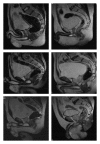Does urinary bladder shape affect urinary flow rate in men with lower urinary tract symptoms?
- PMID: 24511301
- PMCID: PMC3910387
- DOI: 10.1155/2014/846856
Does urinary bladder shape affect urinary flow rate in men with lower urinary tract symptoms?
Abstract
We aimed to investigate the role of urinary bladder shape which may potentially change with advancing age, increased waist circumference, pelvic ischemia, and loosening of the urachus on bladder emptying and UFR. We retrospectively investigated the medical records of 76 men. The patients were divided into two groups according to bladder shapes in MRI scan (cone and spheric shapes). There was a significant difference between the two groups in terms of IPSS, Qmax, Qave, and waist circumference. A positive correlation has been demonstrated between mean peak urinary flow rate measured with UFM and mean flow rate calculated using the CP. There was a significant difference between mean urinary flow rates calculated with CP of cone and sphere bladder shapes. The change in the bladder shape might be a possible factor for LUTS in men and LUTS may be improved if modifiable factors including increased waist circumference and loosening of the urachus are corrected.
Figures




Similar articles
-
International Prostatic Symptom Score-voiding/storage subscore ratio in association with total prostatic volume and maximum flow rate is diagnostic of bladder outlet-related lower urinary tract dysfunction in men with lower urinary tract symptoms.PLoS One. 2013;8(3):e59176. doi: 10.1371/journal.pone.0059176. Epub 2013 Mar 18. PLoS One. 2013. PMID: 23527124 Free PMC article.
-
Role of Bladder Dysfunction in Men with Lower Urinary Tract Symptoms Refractory to Alpha-blocker Therapy: A Video-urodynamic Analysis.Low Urin Tract Symptoms. 2018 Jan;10(1):32-37. doi: 10.1111/luts.12139. Epub 2016 Jul 1. Low Urin Tract Symptoms. 2018. PMID: 27366877
-
Assessment of lower urinary tract symptoms in men by international prostate symptom score and core lower urinary tract symptom score.BJU Int. 2012 May;109(10):1512-6. doi: 10.1111/j.1464-410X.2011.10445.x. Epub 2011 Aug 26. BJU Int. 2012. PMID: 21883834
-
LUTS in pelvic ischemia: a new concept in voiding dysfunction.Am J Physiol Renal Physiol. 2016 Apr 15;310(8):F738-F743. doi: 10.1152/ajprenal.00333.2015. Epub 2016 Jan 20. Am J Physiol Renal Physiol. 2016. PMID: 26792064 Review.
-
Lower Urinary Tract Symptoms: What's New in Medical Treatment?Eur Urol Focus. 2018 Jan;4(1):17-24. doi: 10.1016/j.euf.2018.04.005. Epub 2018 Apr 14. Eur Urol Focus. 2018. PMID: 29665997 Review.
Cited by
-
Validation of a real-time bladder sensation meter during oral hydration in healthy adults: Repeatability and effects of fill rate and ultrasound probe pressure.Low Urin Tract Symptoms. 2019 Sep;11(4):224-231. doi: 10.1111/luts.12275. Epub 2019 Jul 12. Low Urin Tract Symptoms. 2019. PMID: 31298501 Free PMC article.
-
Technical feasibility of uro-dynamic MRI study of voiding biomechanics: a pilot study.Int Urol Nephrol. 2024 Mar;56(3):893-899. doi: 10.1007/s11255-023-03823-7. Epub 2023 Oct 12. Int Urol Nephrol. 2024. PMID: 37823972 Free PMC article.
-
Recurrent Urinary Tract Infection: A Mystery in Search of Better Model Systems.Front Cell Infect Microbiol. 2021 May 26;11:691210. doi: 10.3389/fcimb.2021.691210. eCollection 2021. Front Cell Infect Microbiol. 2021. PMID: 34123879 Free PMC article. Review.
References
-
- Bang WJ, Kim HW, Lee JY, et al. Prostatic urethral angulation associated with urinary flow rate and urinary symptom scores in men with lower urinary tract symptoms. Urology. 2012;80:1333–1337. - PubMed
-
- Pinggera G-M, Mitterberger M, Steiner E, et al. Association of lower urinary tract symptoms and chronic ischaemia of the lower urinary tract in elderly women and men: assessment using colour Doppler ultrasonography. BJU International. 2008;102(4):470–474. - PubMed
-
- Berry SJ, Coffey DS, Walsh PC, Ewing LL. The development of human benign prostatic hyperplasia with age. Journal of Urology. 1984;132(3):474–479. - PubMed
-
- Bushman W. Etiology, epidemiology, and natural history. Urologic Clinics of North America. 2009;36(4):403–415. - PubMed
-
- Sciarra A, D'Eramo G, Casale P, et al. Relationship among symptom score, prostate volume, and urinary flow rates in 543 patients with and without benign prostatic hyperplasia. Prostate. 1998;34:121–128. - PubMed
MeSH terms
LinkOut - more resources
Full Text Sources
Other Literature Sources
Medical
Miscellaneous

